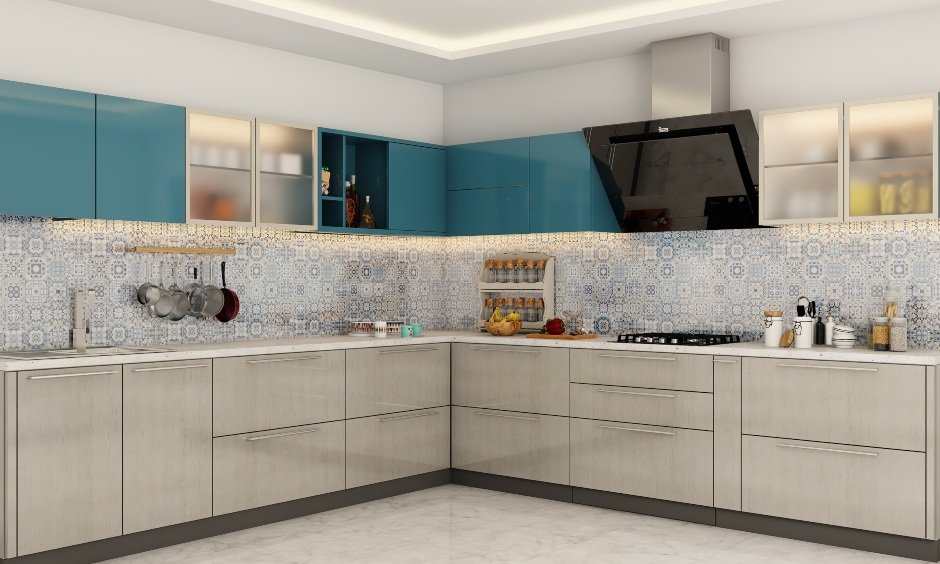Here’s your ultimate guide to choosing between an open kitchen vs closed kitchen
The kitchen isn’t just for cooking—it’s where midnight snacks are concocted, family debates are settled, and you secretly dance to your favourite tunes while stirring the pot. But here’s the sizzling question: Should this hub of activity be an open, airy space that blends with your living room or a cosy, closed-off enclave where you can whip up culinary masterpieces in peace?
Let’s heat up the kitchen debate: open kitchen vs. closed kitchen, India edition, and explore which kitchen style will spice up your home the best. Read on!
Open vs. Closed Kitchen: The Concept
Open kitchen models are characterised by their integration with adjacent living spaces, often merging seamlessly with the dining room and living room. This design fosters a sense of openness and connectivity, making the kitchen a central hub of household activity.
In contrast to open kitchen ideas, a closed-concept kitchen is a separate room enclosed by walls and often a door, creating a distinct and private space for cooking. This traditional design isolates the kitchen from other living areas, providing a clear boundary between cooking and other activities.

Closed Kitchen to Open Kitchen: Before and After Transition are Important
Transitioning from a closed kitchen to an open kitchen can dramatically alter the feel and functionality of a home. Before the change, a closed kitchen might feel cramped and isolated, making social interaction difficult for those cooking.
After the transformation, the kitchen opens up, creating a spacious environment that encourages engagement and interaction. Removing walls can also increase natural light flow and improve the overall aesthetics of the space, making it more inviting.

Open Concept Kitchen Vs Closed Concept: Pros and Cons
Pros
There are no specific ways to approach an open kitchen vs. closed kitchen benefits check.
Open kitchen India designs especially encourage social interaction with family and guests while cooking. They give a spacious feel, creating a larger, more open space by eliminating walls. Additionally, they offer a contemporary touch that enhances the home’s overall beauty. A closed-concept kitchen provides a private space for cooking and meal prep, keeps the cooking smells and noise confined to one area, and usually offers more cabinet and storage space.
Cons
Open and closed kitchen designs have their turn-offs, too, and careful consideration must be given to choosing the right one.
Open kitchen models could be noisy, and cooking smells could spread to adjoining areas. They offer less privacy as cooking activities are visible to everyone, which might be undesirable for some. They often lack sufficient storage compared to closed kitchens, which invite more clutter. On the other hand, closed kitchens can feel isolated from the rest of the household activities. They may feel smaller and more cramped compared to open kitchens. Aesthetically, too, they might look outdated compared to modern open-concept designs.

Open vs. Closed Kitchen Cabinets Design
Cabinetry plays a crucial role in both open and closed kitchen design. In open kitchens, cabinets often need to be good-looking as they are visible from other living areas. Open shelving and glass-front cabinets are popular choices, offering a stylish look and easy access to frequently used items.
Closed kitchens can utilise more traditional cabinets with solid doors, maximising storage space and keeping clutter hidden. This allows for more freedom in cabinet design, focusing on functionality over form.

Best Modular Kitchen Designs
Open Kitchen vs. Closed: Which One is Budget-Friendly?
The cost of converting a kitchen depends mainly on the scope of the project. Generally, an open kitchen can be more expensive if it involves knocking down walls and integrating design elements with adjoining spaces. However, an open kitchen can also add value to a home, potentially offering a return on investment.
Closed kitchens can be more budget-friendly as they typically involve less structural change. Renovations might focus more on updating cabinets, countertops, and appliances without reconfiguring the entire space.

Conclusion
Choosing between an open-concept kitchen vs closed-concept kitchen involves considering various factors, including lifestyle, aesthetic preferences, and budget. Open kitchens offer a modern, spacious feel that encourages social interaction but may come with challenges like noise and smell spread. Closed kitchens provide privacy and containment, which is suitable for those who prefer a distinct cooking space. The final decision should align with your personal needs and how you envision your kitchen functioning within your home. Whether you opt for an open or closed kitchen, thoughtful design and planning can help create a space you’ll love and enjoy for years.
Also, Check Out Our Modern Kitchen Interior Designs
FAQs On Open Vs Closed Kitchen
1. What is the difference between an open and closed kitchen?
An open kitchen integrates with living spaces, promoting interaction and a spacious feel, while a closed kitchen is a separate, enclosed room, providing privacy and containment of smells and noise.
2. What are the benefits of a closed kitchen?
Closed kitchens offer privacy, contain cooking smells and noise, and provide ample storage and organisation space, making them ideal for intensive cooking without disturbing other household activities.
3. Is an open kitchen better than a closed kitchen?
Neither is universally better; it depends on personal preferences and lifestyle. Open kitchens promote social interaction and a modern look, while closed kitchens offer privacy and better containment of smells and noise.
4. Is an open kitchen good for Indian cooking?
Open kitchens can be challenging for Indian cooking due to strong aromas and extensive use of spices. Adequate ventilation and regular cleaning are essential to manage smells and maintain cleanliness.



















